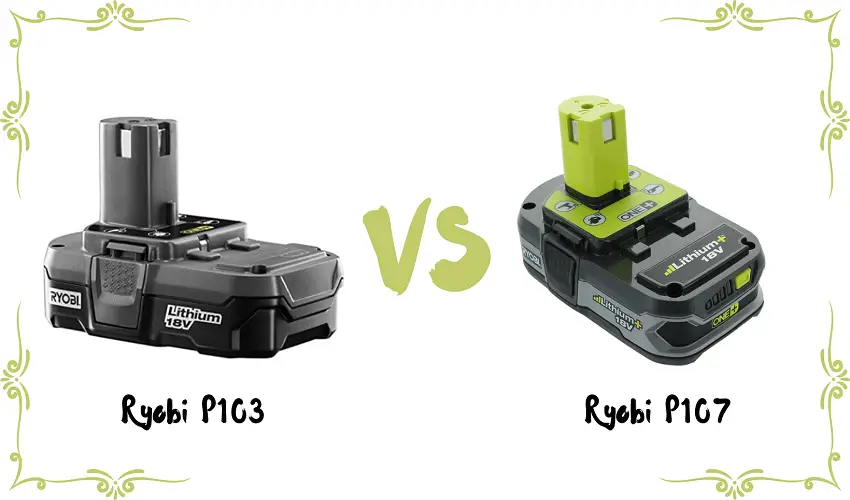Ryobi P103 and P107 are both 18-volt batteries, but P107 has a higher capacity than the P103. The P107 is more suitable for longer runtime needs due to its higher capacity.
When choosing between the Ryobi P103 and P107 batteries, it’s essential to consider your power tool usage and how long you typically work without recharging. The P107 battery offers a longer runtime, making it ideal for heavy-duty tasks or extended projects.
On the other hand, the P103 is a more compact and lightweight option if portability is a priority. Understanding the differences between these two batteries will help you choose the best option for your specific needs.
Contents
Ryobi P103 Vs Ryobi P107
Battery Capacity
The comparison between Ryobi P103 and P107 primarily revolves around their battery capacity, which plays a crucial role in determining the tool’s runtime and performance.
Comparison Of Mah Rating
Ryobi P103 has an mAh rating of 1.5Ah, while P107 offers a higher capacity with a rating of 1.3Ah.
Implications For Runtime
- Ryobi P103: Lower mAh rating leads to shorter runtime per charge.
- Ryobi P107: Higher mAh rating provides extended runtime for longer use.
Charging Performance
When it comes to cordless power tools, efficient charging performance is crucial. It ensures that you can continue working without unnecessary interruptions and delays.
In this section, we will explore the charging performance of the Ryobi P103 and P107 batteries, comparing their charging time and efficiency in the charging cycle.
Comparison Of Charging Time:
One significant factor to consider is how long it takes for the battery to fully charge. The Ryobi P103 and P107 batteries differ in their charging times, offering you options based on your specific needs and preferences.
| Battery | Charging Time |
|---|---|
| Ryobi P103 | ∼30 minutes |
| Ryobi P107 | ∼60 minutes |
The Ryobi P103 takes approximately 30 minutes to charge fully, providing a relatively quick turnaround time for when you need to get back to work swiftly.
On the other hand, the Ryobi P107 takes approximately 60 minutes to charge entirely, ideal for longer projects that require extended periods of continuous tool usage.
Efficiency In Charging Cycle:
In addition to charging time, the efficiency in the charging cycle is a crucial aspect to consider when selecting between the Ryobi P103 and P107 batteries. An efficient charging cycle ensures that you can maximize the battery’s performance and longevity.
The Ryobi P103 battery is designed with efficiency in mind, delivering a quick and consistent charge throughout its lifecycle. This means that you can rely on a steady power supply without experiencing fluctuations or sudden power drainage during your work.
Similarly, the Ryobi P107 battery also offers exceptional efficiency in its charging cycle, ensuring that you can work with confidence, knowing that your battery will perform reliably.
Whether you are using it for light-duty tasks or demanding projects, the P107 battery maintains a consistent power output, allowing you to focus on your work without worrying about battery performance.
Having explored the charging performance of the Ryobi P103 and P107 batteries, including their charging time and efficiency in the charging cycle, you can now make an informed decision based on your specific needs and project requirements.
So, whether you value a quick recharge or require a battery with a longer runtime, rest assured that Ryobi has you covered.
Compatibility
Devices Compatible With Each Battery
The Ryobi P103 and P107 batteries are compatible with a wide range of Ryobi power tools, providing users with versatility and convenience.
The P103 battery is suitable for use with older Ryobi 18V products, whereas the P107 battery is compatible with newer 18V tools and equipment.
Interchangeability Between Models
Both the P103 and P107 batteries are interchangeable, allowing users to effortlessly switch between different Ryobi tools without the need for multiple battery packs. This interchangeability ensures seamless operation and flexibility when tackling various projects.
Price And Value
When it comes to cordless power tools, the price and value of the batteries are crucial factors to consider. In this comparison of Ryobi P103 vs P107, we analyze the cost analysis and long-term cost-effectiveness of these batteries.
Cost Analysis
The Ryobi P103 battery boasts a competitive price point, making it an affordable option for those seeking a reliable power source for their tools.
However, the P107, being an upgraded version, comes at a slightly higher price. Despite this, both options offer good value for the features they provide.
Long-term Cost-effectiveness
When considering long-term cost-effectiveness, the P107 demonstrates superior performance. Its extended charge retention and overall lifespan make it a cost-effective investment in the long run.
While the initial cost may be higher, the durability and longevity of the P107 provide significant value over time, reducing the need for frequent replacements.
Frequently Asked Questions On Ryobi P103 Vs P107
How Many Amps Does A Ryobi P107 Battery Have?
The Ryobi p107 battery has a capacity of 1. 5 amp hours (Ah).
Which Ryobi Batteries Are Interchangeable?
Ryobi batteries with the same voltage are interchangeable, such as 18V batteries for Ryobi cordless tools.
What Is The Difference Between Ryobi High Performance And Regular?
Ryobi high performance tools offer more power and durability compared to regular models. They are designed for tougher tasks.
Are The Ryobi P102 And P108 Interchangeable?
Yes, the Ryobi P102 and P108 batteries are interchangeable.
Conclusion
To summarize, the comparison between Ryobi P103 and P107 highlights several important factors to consider. While the P103 offers a longer runtime, the P107 provides a higher power output.
Ultimately, the choice depends on your specific needs and preferences. Both battery models offer reliable performance and compatibility with various Ryobi tools.
Whether you prioritize longer usage or increased power, Ryobi has a battery option to suit your requirements. Choose wisely and optimize your tool’s performance.

